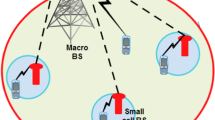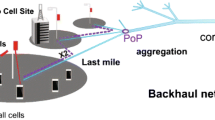Abstract
The massive multiple-input–multiple-output that enhances energy efficiency and spectral efficiency is the primary technology for fifth generation wireless networks. A move toward heterogeneous elements such as microcells, femtocells, picocells as well as remote radio heads, characterised by physical measurements, backhauls, transmission and propagation, is now underway to ensure an economical transition to the cellular network infrastructure, that is far from expensive high power mounted base stations. This adaptation presents many obstacles to network operations and co-existence. The proposed work therefore provides a design for a 28 GHz microwave wireless backhaul link for small cell base stations (SBSs) as well as the number of antennas required for the base station (BS) to achieve a target backhaul rate of 10 Gbit/s within a given transmit power of 40 dBm. In this work a distributed beamforming algorithm is formulated in a multi-cell scenario using methods from random matrix theory, under the assumption that the system dimensions are large. The design purpose is to minimize the total transmit power over all BSs according to the constraints of the signal-to-interference-and-noise ratio (SINR) as beamformers are integrated in a distributed manner. The BSs may only need to share the channel statistics in the suggested algorithm, instead of the instant channel state information. The simulation results show that the proposed algorithm strongly satisfies the target SINR constraints as the number of SBSs per cell grows high.






Similar content being viewed by others
References
Osseiran, A., Boccardi, F., Braun, V., Kusume, K., Marsch, P., Maternia, M., et al. (2014). Scenarios for 5G mobile and wireless communications: The vision of the metis project. IEEE Communications Magazine, 52(5), 26–35.
Wunder, G., Jung, P., Kasparick, M., Wild, T., Schaich, F., Chen, Y., et al. (2014). 5GNOW: Non-orthogonal, asynchronous waveforms for future mobile applications. IEEE Communications Magazine, 52(2), 97–105.
Jungnickel, V., Manolakis, K., Zirwas, W., Panzner, B., Braun, V., Lossow, M., et al. (2014). The role of small cells, coordinated multipoint, and massive MIMO in 5G. IEEE Communications Magazine, 52(5), 44–51.
Ge, X., Tu, S., Mao, G., Wang, C. X., & Han, T. (2016). 5G ultra-dense cellular networks. IEEE Wireless Communications, 23(1), 72–79.
Andrews, J. G. (2013). Seven ways that HetNets are a cellular paradigm shift. IEEE Communications Magazine, 51(3), 136–144.
“Backhaul technologies for small cells,” small cell forum Rep. 049 03 01 (2013).
Jaber, M., Imran, M. A., Tafazolli, R., & Tukmanov, A. (2016). 5G backhaul challenges and emerging research directions: A survey. IEEE Access, 4, 1743–1766.
“Backhaul technologies for small cells: Use cases, requirements and solution,” small cell forum, Dursley, U.K., Tech. Rep. 049 01 01 (2013).
Robson, J. (2012). Small cell backhaul requirements, NGMN Alliance (2012). White Paper.
Zhang, J. A., Ni, W., Matthews, J., Sung, C.-K., Huang, X., Suzuki, H., & Collings, I. (2014). Low latency integrated point-to-multipoint and E-band point-to-point backhaul for mobile small cells. In 2014 IEEE international conference on communications workshops (ICC) (pp. 592–597).
Kela, P., Costa, M., Turkka, J., Leppnen, K., & Jntti, R. (2016). Flexible backhauling with massive MIMO for ultra-dense networks. IEEE Access, 4, 9625–9634.
Li, B., Zhu, D., & Liang, P. (2015). Small cell in-band wireless backhaul in massive MIMO systems: A cooperation of next-generation techniques. IEEE Transactions on Wireless Communications, 14(12), 7057–7069.
Tabassum, H., Sakr, A. H., & Hossain, E. (2016). Analysis of massive MIMO-enabled downlink wireless backhauling for full-duplex small cells. IEEE Transactions on Communications, 64(6), 2354–2369.
Coldrey, M., Koorapaty, H., Berg, J. E., Ghebretensa, Z., Hansryd, J., Derneryd, A., et al. (2012). IEEE vehicular technology conference (VTC Fall) (pp. 1–5).
Coldrey, M., Berg, J. E., Manholm, L., Larsson, C., & Hansryd, J. (2013). Non-line-of sight small cell backhauling using microwave technology. IEEE Communications Magazine, 51(9), 78–84.
Ni, W., Collings, I. B., Wang, X., & Liu, R. P. (2014). Multi-hop point-to-point FDD wireless backhaul for mobile small cells. IEEE Wireless Communications, 21(4), 88–96.
Bojic, D., Sasaki, E., Cvijetic, N., Wang, T., Kuno, J., Lessmann, J., et al. (2013). Advanced wireless and optical technologies for small-cell mobile backhaul with dynamic software-defined management. IEEE Communications Magazine, 51(9), 86–93.
Taori, R., & Sridharan, A. (2015). Point-to-multipoint in-band mmWave backhaul for 5G networks. IEEE Communications Magazine, 53(1), 195–201.
Semiari, O., Saad, W., Daw, Z., & Bennis, M. (2015). Matching theory for backhaul management in small cell networks with mmWave capabilities. In 2015 IEEE international conference on communications (ICC) (pp. 3460–3465.)
Demers, F., Yanikomeroglu, H., & St-Hilaire, M. (2011). A survey of opportunities for free space optics in next generation cellular networks. In 2011 Ninth annual communication networks and services research conference (pp. 210–216).
Khalighi, M. A., & Uysal, M. (2014). Survey on free space optical communication: A communication theory perspective. IEEE Communications Surveys Tutorials, 16(4), 2231–2258.
Douik, A., Dahrouj, H., Al-Naffouri, T. Y., & Alouini, M. S. (2016). Hybrid radio/freespace optical design for next generation backhaul systems. IEEE Transactions on Communications, 64(6), 2563–2577.
Curran, M., Rahman, M. S., Gupta, H., Kai Zheng, J. L., Das, S. R., & Mohamed, T. (2017). Fsonet: A wireless backhaul for multi-gigabit picocells using steerable free space optics. MobiCom.
Bjornson, E., Hoydis, J., & Sanguinetti, L. (2017). Massive MIMO networks: Spectral, energy, and hardware efficiency. Foundations and Trends in Signal Processing, 11(3–4), 154–655. https://doi.org/10.1561/2000000093.
Dahrouj, H., & Yu, W. (2010). Coordinated beamforming for the multicell multi-antenna wireless system. IEEE Transactions on Wireless Communications, 9(5), 1748–1759.
Lakshminaryana, S., Hoydis, J., Debbah, M., & Assaad, M. (2010). Asymptotic analysis of distributed multi-cell beamforming. In Proceedings of the IEEE PIMRC (pp. 2105–2110). IEEE.
Li, X., Bjornson, E., Larsson, E. G., Zhou, S., & Wang, J. (2015). A multi-cell MMSE detector for massive MIMO systems and new large system analysis. In 2015 IEEE global communications conference (GLOBECOM) (pp. 1–6). IEEE.
Evolved Universal Terrestrial Radio Access (E-UTRA); Radio frequency (RF) system scenarios (Release 8). 2008. 3GPP TS 36.942.
Feasibility study for further advancements for E-UTRA (Release 12). 2014. 3GPP TS 36.912.
Akdeniz, M. R., Liu, Y., Samimi, M. K., Sun, S., Rangan, S., Rappaport, T. S., & Erkip, E. (2014). Millimeter wave channel modeling and cellular capacity evaluation. IEEE Journal on Selected Areas in Communications, 32(6), 1164–1179.
Author information
Authors and Affiliations
Corresponding author
Additional information
Publisher's Note
Springer Nature remains neutral with regard to jurisdictional claims in published maps and institutional affiliations.
Rights and permissions
About this article
Cite this article
Jeyakumar, P., Malar, E., Niveda, S. et al. Optimal Microwave Wireless Backhaul Link Design Using a Massive MIMO for 5G HetNet-Practical Deployment Scenario. Wireless Pers Commun 120, 2117–2133 (2021). https://doi.org/10.1007/s11277-021-08543-8
Accepted:
Published:
Issue Date:
DOI: https://doi.org/10.1007/s11277-021-08543-8




